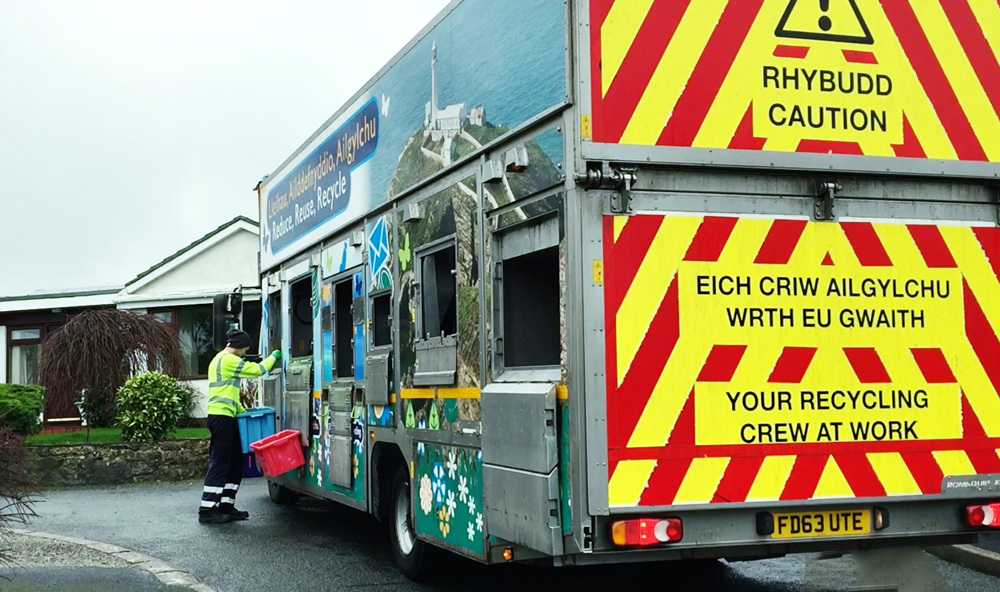Welsh Government mandates 3-weekly residual collections
The Welsh Government's updated Collections Blueprint 2025 mandates three-weekly residual waste collections and ultra-low emission vehicles while strengthening material separation requirements to achieve its 70 per cent recycling target and support the transition to a circular economy.
 The Welsh Government has published an updated Collections Blueprint 2025 that strengthens requirements for local authorities to achieve its ambitious 70 per cent recycling target by mandating less frequent residual waste collections and enhanced material separation.
The Welsh Government has published an updated Collections Blueprint 2025 that strengthens requirements for local authorities to achieve its ambitious 70 per cent recycling target by mandating less frequent residual waste collections and enhanced material separation.
The refreshed guidance, building on Wales' position as the world's second-best recycling nation with a 66.6 per cent rate in 2023-24, introduces pioneering requirements that go beyond the original 2011 blueprint. Most significantly, the document now recommends collecting residual waste no more than once every three to four weeks, with residual capacity limited to 60 litres or less per week for standard service.
The updated blueprint represents a marked shift from previous guidance, with local authorities including Caerphilly County Borough Council already implementing three-weekly collections alongside new kerbside separation systems. Modelling from the Welsh Government indicates that three-weekly collections combined with kerbside sort systems can add six per cent to recycling figures.
Enhanced material separation drives quality improvements
A key development in the 2025 blueprint is the recommendation for local authorities to provide three or more containers to households, representing an increase from the previous two-container minimum. The enhanced separation requires materials to be collected in distinct streams: paper and cardboard; glass; and mixed plastic, metal and cartons.
This approach aligns with regulations now applying to non-domestic properties in Wales and addresses quality concerns that have emerged as recycling volumes increase. Research cited in the blueprint shows contamination levels of just 6.4 per cent for separately collected materials compared to 20.3 per cent for co-mingled systems.
The blueprint maintains its support for kerbside sort collection using single-pass resource recovery vehicles (RRVs), which enable crews to reject contaminated materials at the point of collection and provide immediate feedback to residents. This approach has proven successful in authorities like Pembrokeshire and Bridgend, which achieve the highest recycling rates in Wales.
Net zero requirements drive vehicle transformation
For the first time, the Collections Blueprint explicitly requires local authorities to procure Ultra Low Emission Vehicles (ULEV) as the default option for new waste collection vehicles to support the public sector's net zero target by 2030. This builds on pioneering work by councils including Conwy County Borough Council, which became the first in Wales to operate electric recycling collection vehicles in 2022.
The Welsh Government has provided £1.575 million in capital funding to Conwy for nine ultra-low emission recycling vehicles, demonstrating the financial support available for fleet transformation (https://gov.wales/decision-reports-2025). The blueprint emphasises that decarbonisation plans must be in place for all collection services, with vehicles served by appropriately designed depots including charging infrastructure for electric fleets.
The guidance also introduces mandatory provision of separate Absorbent Hygiene Products (AHP) collections using purple 60-litre bags, addressing equality considerations for households with specific needs while supporting reduced residual waste frequencies.
Circular economy integration strengthens reuse focus
The 2025 blueprint significantly expands its coverage of waste prevention, reuse and repair activities as part of Wales' Beyond Recycling strategy to create a truly circular economy. Local authorities must now provide networks of reuse points and signpost repair organisations, with at least one reuse and repair hub required at either a Reuse and Recycling Centre or in a town centre.
Reuse and Recycling Centres are required to achieve at least 85 per cent recycling and reuse rates, with enhanced policies to control unsorted residual waste. The blueprint introduces comprehensive equality, diversity and inclusion requirements, mandating consideration of how services affect people with protected characteristics to ensure no group is unfairly disadvantaged.
Bulky waste collections must prioritise reuse, repair and recycling in descending order, with direct delivery to disposal facilities prohibited. This represents a significant shift towards circular economy principles that keep materials in use for as long as possible.
The blueprint estimates that full adoption across Wales would deliver a national recycling rate exceeding 70 per cent, supporting Wales' trajectory from around 5 per cent recycling in the 1990s to its current world-leading position behind only Austria in global rankings.




